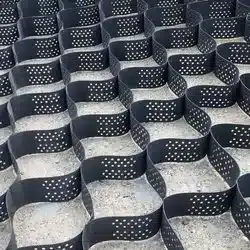+86-159 9860 6917
info@geofantex.com
geofantex@gmail.com
+86-400-8266163-44899
Geosynthetic materials are versatile, eco-friendly, and budget-friendly solutions for various uses in construction, civil engineering, and environmental care. In this article, we’ll delve into what geosynthetic materials are and their roles in drainage systems, filtration, separation, and water movement. We’ll also discuss the specific use of geosynthetic clay liners, four key applications of geosynthetics, and the many benefits they offer.

What are geosynthetic materials, and how are they used?
Geosynthetic materials, or geosynthetics, are synthetic materials used with soil, rock, earth, or other geotechnical-related materials as integral components of civil engineering projects, structures, or systems. Made from polymers and tailored for specific qualities like strength, durability, and permeability, they enhance the performance and longevity of various projects. These materials primarily serve to stabilize soil, control erosion, and manage moisture. They find common applications in:
- Reinforcement: Strengthening soil in road construction, retaining walls, and embankments.
- Separation: Preventing the mixing of different soil layers, reducing contamination risks, and ensuring pavement and foundation stability.
- Filtration: Allowing water passage in drainage systems while retaining soil particles.
- Erosion Control: Playing a pivotal role in preventing soil erosion at coastlines, riverbanks, and construction sites.
What are the uses of geosynthetic clay liners?
Geosynthetic clay liners (GCLs) are a specialized type of geosynthetic material built for containment, serving as a barrier to water, leachate, other liquids, and sometimes gases, with a primary focus on environmental protection. GCLs comprise bentonite clay enclosed by two geotextile layers. They are widely applied in landfills, pond liners, and containment systems for hazardous waste, providing a highly impermeable shield that halts the spread of contaminants into the surroundings. GCLs also play a pivotal role in secondary containment systems, ensuring ecosystem and water resource safety by preventing leaks and seepage.

What are the four major applications of geosynthetics?
- Road Construction: Geosynthetics are used to reinforce road bases, extending the lifespan of roads and reducing maintenance costs.
- Erosion Control: Geosynthetic materials are essential for stabilizing slopes, protecting coastlines, and preventing soil erosion.
- Environmental Protection: They play a significant role in containment systems, such as landfill liners and hazardous waste storage, safeguarding the environment from contamination.
- Water Management: Geosynthetics are used in water and wastewater treatment facilities, ensuring proper drainage and filtration.
What are the advantages of geosynthetic material?
The benefits of using geosynthetic materials are plentiful and encompass:
- Cost-Effective: These materials are easy to use and cost-effective, often saving money in comparison to traditional construction methods because they require less labor and fewer materials.
- Environmental Benefits: They aid in environmental protection by preventing soil erosion, reducing contamination risks, and enabling sustainable construction practices.
- Durability: Geosynthetics offer long-term performance and resilience against environmental factors, ensuring the longevity of infrastructure.
- Versatility: They are easy to use and adaptable to a wide range of applications, from transportation projects to environmental protection efforts.
In conclusion, geosynthetic materials have revolutionized the field of civil engineering and construction by offering innovative solutions that enhance infrastructure stability and environmental protection. Their diverse applications, including geosynthetic clay liners and many others, along with numerous advantages, make them an invaluable resource in the modern construction industry.



Get Free Sample
We’ll respond as soon as possible(within 12 hours)





















